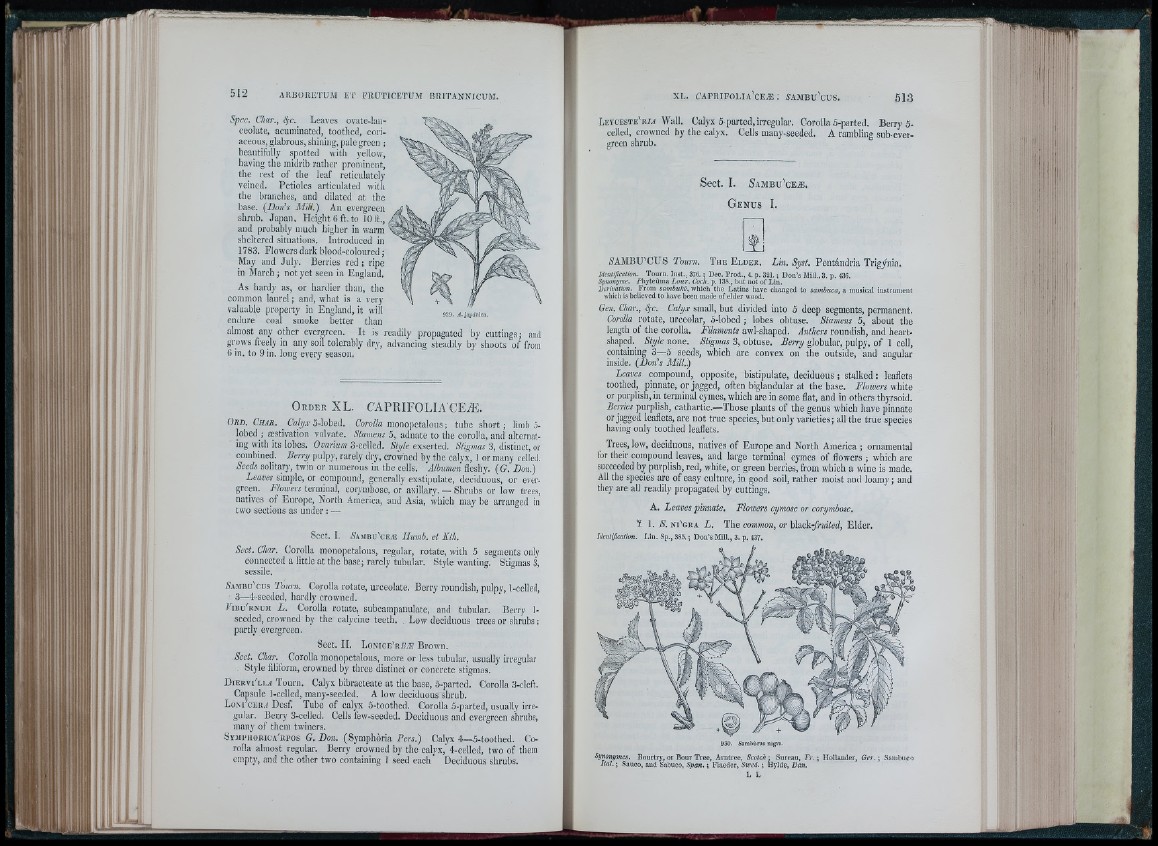
51 2 A R B O R E T U M E T F R U T IC E T U M B IU T A N N IC U M .
Spcc. CJiar., 4c. Leaves ovate-lan-
ceolate, acuminated, toothed, coriaceous,
glabrous, sliiuiiig, pale green ;
beautifully spotted with yellow,
having the midrib rather prominent,
the rest of the leaf reticulately
veined. Petioles articulated with
the branches, and dilated at the
base. (Doris MiH.) An evergreen
shrub. .Japan. Height G ft. to 10 ft., ,
and probably much higher in warm '
sheltered situations. Introduced in
1783. Flowers dark blood-coloured;
May and July. Berries red ; ripe
in March ; not yet seen in England.
As hardy as, or hartlier than, the
common laurel; and, what is a very
valuable property in England, it will g»,.
endure coal smoke better than
almost any other evergreen. It is readily propagated by cuttings; and
grows freely in any soil tolerably dry, advancing steadily by shoots of from
6 in. to 9 in. long every season.
O r d e r X L . C A P R I F O L I A C E Æ .
Ord. Char. ^ Calyx S-Iobed. Corolla monopetalous ; tube short ; limb 5-
lobed ; æstivation valvate. Stamens 5, adnate to the corolla, and alternating
with its lobes. Ovarium 3-celled. Style exserted. Stigmas 3, distinct, or
combined. Berry pulpy, rarely dry, crowned by the calyx, 1 or many celled.
Seeds solitary, twin or numerous in the cells. Albumen fleshy, (G. Don.)
Leaves simple, or compound, generally exstipulate, deciduous, or evergreen.
Flowers terminal, corymbose, or axillary, — Shrubs or low trees,
natives of Europe, North America, and Asia, which may he arranged in
two sections as untler : —
Sect. I, S a .u d u ' c e * Humb. et Kth.
Sect. Char. Corolla monopetalous, regular, rotate, with 5 segments only
connected a little at the base; rarely tubular. Style wanting. Stigmas 3,
sessile.
S a m b u ' o l' s Tourn. Corolla rotate, urceolate. Berry roundish, p u l p y , 1-celled,
3—4-seeded, hardly crowned.
E i b u ' b n o m L . Corolla rotate, subcampanulate, and tubular. Berry 1-
seeded, crowned by the calycine teeth. Low deciduous trees or shrubs ;
partly evergreen.
Sect. II. L o n i c e ' r e .® Brown.
Sect. Char. Corolla monopetalous, more or less tubular, usually irregular
Style filiform, crowned by three distinct or concrete stigmas.
D i e r v i ' l i . « Tourn. Calyx bibracteate at the base, S-parted. Corolla 3-cleft.
Capsule 1-celled, many-seeded. A low deciduous shrub.
LoM%ER/i Desf. Tube of calyx 5-toothed. Corolla 5-parted, usually irregular.
Bexi-y 3-celled. Cells few-seeded. Deciduous and evergreen shrubs,
many of them twiners.
S y m b h o r i c a ' r p o s G. Don. (Syinphoria Pers.) Calyx 4—5-toothed. Corolla
almost regular. Berry crowned by the calyx, 4-celled, two of them
empty, and the other two containing 1 seed each" Deciduous shrubs.
X L . C A P R I F O L Ia ' c EÆ : A’AM B U 'C U S . 5 1 3
L e y c e s t e ' r j a Wall. Calyx 5-parted, irregular. Corolla 5-parted. Berry 5-
celled, crowned by the calyx. Cells many-seeded. A rambling sub-evergreen
shrub.
S e c t . I . S a m b u ' c e æ .
G e n u s I .
SAMBU'CUS Tourn. T h e E l d e r . Lin. Syst. Pentándria Trigynia.
Ideniijication. Tourn. Inst., 376.; Dec. Prod., 4. p. 321.; Don’s Mill., 3. p. 436.
Synonyme. Thyteüma Lour. Coch. p. 138., bnt not of Lin.
Derivation. From sambuke, which the Latins have changed to sambuca, a musical instrument
which is believed to have been made of elder wood.
Gen. Char., 4c. Calyx small, but divided into 5 deep segments, permanent.
Corolla rotate, urceolar, 5-lobed ; lobes obtuse. Stamens 5, about the
length of the corolla. Filaments awl-shaped. Anthers roundish, and heart-
shaped. Style none. Stigmas 3, obtuse. Berry globular, pulpy, of 1 cell,
containing 3—5 seeds, which are convex on the outside, and angular
inside. (Doris Mill.)
Leaves compound, opposite, bistipulate, deciduous; stalked: leaflets
toothed, pinnate, or jagged, often biglandular at the base. Floivers white
or purplish, in terminal cymes, which are in some flat, and in others thyrsoid.
Bcnies purplish, cathartic.—Those plants of the genus which have pinnate
or jagged leaflets, are not true species, but only varieties; all the true species
having only toothed leaflets.
Trees, low, deciduous, natives of Europe and North America ; ornamental
for their compound leaves, and large terminal cymes of flowers ; which are
succeeded by purplish, red, white, or green berries, from which a wine is made.
All the species are of easy culture, in good soil, rather moist and loamy ; and
they are all readily propagated by cuttings.
A. Leaves pinnate. Flowers cymose or corymbose.
X I. S. Ni'GRA L, The common, or h\o.Qkrfruited, Elder.
Identification. Lin. Sp., 385.; Don’s Mill., 3. p. 437.
930. Sambticui nigm.
Bourtry, or Bour Tree, Arntree, Scotch; Sureau, F?. ; Hollander, Ge r.; Sambuco
Ital. ; Sauco, and Sabuco, Span. ; Flaeder, Swed. ; Hylde, Dan.
'i! I¡